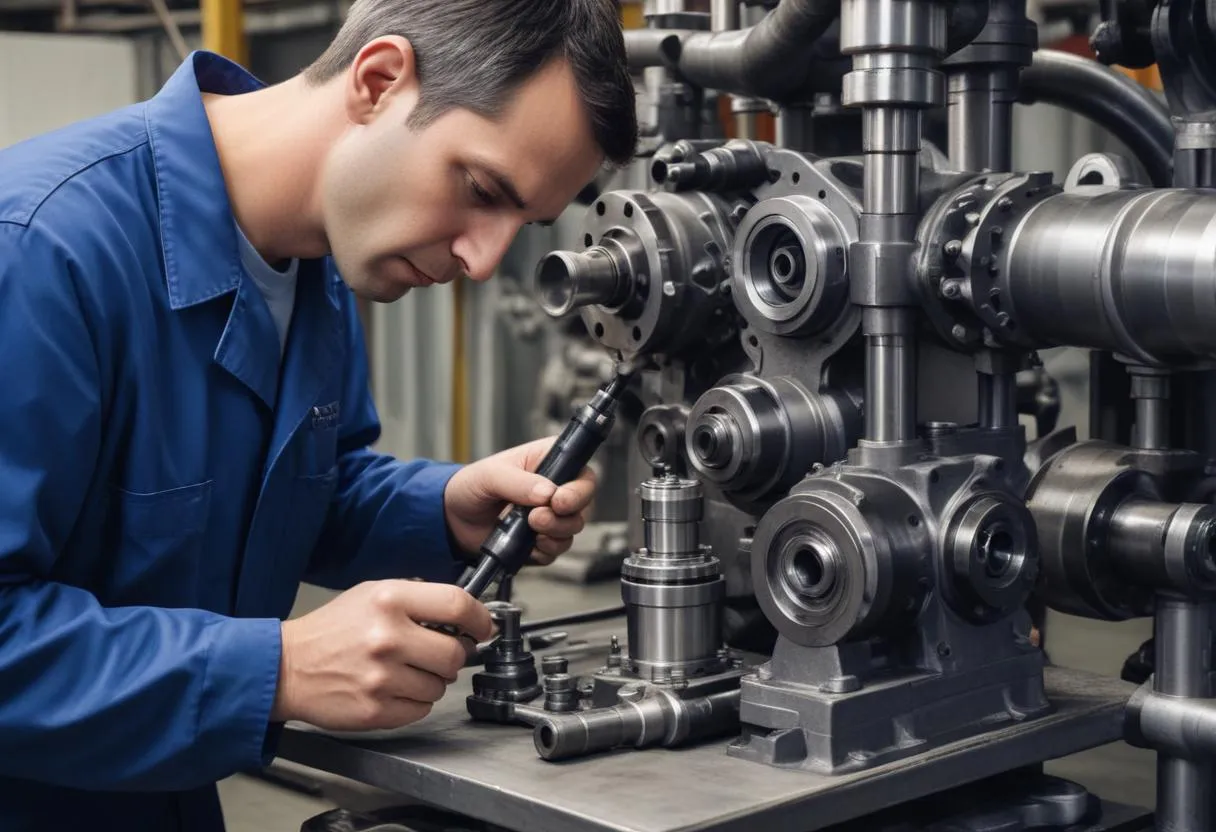 Viscosity is a measure of a fluid’s resistance to flow and deformation due to an applied force. It is a crucial factor in determining the behavior of liquids within pumping systems. When dealing with high-viscosity fluids, such as oils, syrups, or heavy fuels, understanding how this physical property impacts pump performance is essential.
Viscosity is a measure of a fluid’s resistance to flow and deformation due to an applied force. It is a crucial factor in determining the behavior of liquids within pumping systems. When dealing with high-viscosity fluids, such as oils, syrups, or heavy fuels, understanding how this physical property impacts pump performance is essential.
| Viscosity Type | Description | Example |
|---|---|---|
| Dynamic Viscosity | Measures the force needed to move a layer of fluid in relation to another layer. | Honey at room temperature |
| Kinematic Viscosity | Ratio of dynamic viscosity to fluid density, useful in the characterization of flow behavior. | Motor oil |
The impact of viscosity on pumping systems is multifold. High viscosity influences not only the type of pump chosen but also its energy consumption and efficiency. Here’s how:
- Flow Rate: High-viscosity fluids flow slower than low-viscosity fluids under the same conditions. This requires pumps to operate at lower speeds to accommodate the fluid’s resistance to flow.
- Energy Requirements: Pumping high-viscosity fluids requires more power. Increased resistance within the fluid leads to higher energy consumption compared to pumping lower viscosity fluids.
- Pump Sizing: Systems handling viscous fluids need to be carefully sized. Incorrect sizing can lead to inadequate flow rates or excessive pressure drops.
- Wear and Tear: The increased resistance not only demands more from the pump’s drive systems but also contributes to faster wear and tear. This can escalate maintenance requirements and shorten the lifespan of pumping components.
Understanding these impacts helps in designing more effective and efficient pumping systems. By considering the specific characteristics of the fluid, such as its viscosity at operating temperatures, engineers and system designers can optimize both the pump and the pumping system configuration to handle high-viscosity fluids effectively. This optimization includes selecting suitable pump types, such as positive displacement pumps, which are typically favored for high-viscosity applications due to their proficiency in generating sufficient pressure.
Effective design considerations also include taking into account the following parameters:
- Temperature: Since viscosity is temperature-dependent, maintaining an optimal temperature is crucial for consistent fluid handling.
- Pressure drops: Minimizing pressure drops across the pumping system can help in maintaining a steady flow rate and reducing energy losses.
- System layout: Streamlining the layout of pipes, valves, and fittings to reduce resistance and facilitate smoother fluid flow.
Moreover, recognizing and addressing the unique challenges posed by high-viscosity fluids ensures not only operational efficiency but also longevity and reliability of the pumping systems. Continual monitoring and adjustment of operating conditions can preempt many common issues associated with high-viscosity pumping, such as clogging and mechanical stress.
Choosing the right pump for high-viscosity fluids
Selecting the appropriate pump type for handling high-viscosity fluids necessitates a comprehensive understanding of both the fluid properties and pump technologies available. Different pump types offer varying advantages when dealing with viscous fluids, and choosing the wrong type can lead to inefficiency and equipment failure. Here are key factors and suitable pump options for working with high-viscosity tasks:
Positive Displacement Pumps: For most high-viscosity applications, positive displacement (PD) pumps are preferred over centrifugal pumps. PD pumps maintain a consistent flow rate despite varying pressures, which is crucial when handling viscous fluids. They operate by transferring fluid at the same rate irrespective of the intake pressure, ideal for thick, sticky fluids like oils, paints, or syrups. Common types of PD pumps include:
- Rotary Lobe Pumps: These are well suited for fluids of medium to extremely high viscosity, as they provide gentle handling crucial for shear-sensitive fluids.
- Gear Pumps: Commonly used for less volatile and lower shear-sensitive fluids, gear pumps excel in continuous, high-pressure applications.
- Screw Pumps: With a capability to handle varying viscosities and generate high pressures, screw pumps are a go-to for many industrial uses.
- Progressive Cavity Pumps: Excellent for mixed media that includes solids, these pumps handle highly viscous slurries and pastes effortlessly.
Pump Material: The material of the pump components is crucial, particularly when dealing with corrosive or highly viscous fluids. Stainless steel and other robust materials help reduce wear and enhance pump life. It’s important for the pump components to withstand the stress exerted by high-viscosity fluids.
Rotor/Stator Technology: Particularly in progressive cavity pumps, the rotor and stator must be perfectly matched to handle the viscosity. Incorrect configurations can lead to increased power consumption and reduced efficiency.
Drive Systems: High-viscosity fluids require pumps with powerful drive mechanisms. The motors and drives should be capable of managing the high resistance and stress involved in moving viscous fluids. This can include variable frequency drives, which allow for speed adjustments to handle fluctuations in viscosity or flow requirements.
| Pump Type | Viscosity Range | Typical Applications |
|---|---|---|
| Rotary Lobe | Medium to High | Food products, pharmaceuticals |
| Gear Pump | Low to High | Petrochemicals, adhesives |
| Screw Pump | Medium to Very High | Oil & gas, wastewater |
| Progressive Cavity | High to Very High | Waste sludge, heavy cream |
Flow Control: Achieving precise flow control is a primary challenge with high-viscosity fluids. Effective flow management can be accomplished through the use of precision metering and the appropriate selection of pump speed and accessories.
When selecting a pump, conducting a detailed analysis of the fluid properties such as viscosity at operating temperatures, as well as external factors like environmental conditions and space constraints, is essential. Combining this knowledge with real-world testing and consulting with pump experts can lead to the development of highly optimized and reliable pumping systems tailored to high-viscosity applications.
By addressing each of these critical aspects, organizations can ensure that their selected pumping solution will handle high-viscosity fluids efficiently and with minimal maintenance issues. Each component, from pump type to material selection and drive system, plays a pivotal role in the successful implementation of these systems. Proper assessment and selection can significantly prolong the lifespan and enhance the efficiency of the pumping process.
Maintenance and troubleshooting for viscosity-related issues
 Maintaining a pumping system that handles high-viscosity fluids demands a dedicated approach to both routine checks and targeted troubleshooting. The unique characteristics of such fluids often lead to distinct maintenance challenges, primarily due to the increased wear and operational strains these substances impose. Detailed below are key maintenance strategies and common troubleshooting tips that are essential to ensure smooth, continuous operation and to extend the lifespan of the equipment.
Maintaining a pumping system that handles high-viscosity fluids demands a dedicated approach to both routine checks and targeted troubleshooting. The unique characteristics of such fluids often lead to distinct maintenance challenges, primarily due to the increased wear and operational strains these substances impose. Detailed below are key maintenance strategies and common troubleshooting tips that are essential to ensure smooth, continuous operation and to extend the lifespan of the equipment.
Regular Maintenance Checks:
- Lubrication: Ensure all moving parts are regularly lubricated to minimize friction and wear—critical in systems handling viscous materials which tend to exert more force.
- Seal Integrity: Periodically inspect and replace seals as needed. High-viscosity fluids can cause accelerated wear on seals and may further lead to leaks if not monitored closely.
- Filter Cleaning: High-viscosity fluids can quickly clog filters, obstructing flow and causing pressure buildups. Regular cleaning or replacement of filters is paramount.
- Temperature and Pressure Monitoring: Constantly monitor these parameters as fluctuations can significantly affect the viscosity of the fluid and thus its handling characteristics.
Troubleshooting Common Issues:
| Issue | Possible Cause | Solution |
|---|---|---|
| Decreased Flow Rate | clogging in the pipeline or at the pump intake, increased fluid viscosity due to temperature drop | Check and clean filters, adjust temperature controls |
| Excessive Pump Wear | inappropriate pump type for viscosity, insufficient lubrication | Switch to a more suitable pump, ensure adequate lubrication |
| Overheating | over exertion due to high fluid viscosity, inadequate motor cooling | Install a more powerful cooling system, consider a pump with a more robust drive system |
To prevent these issues from arising, it is advisable to perform a preventative maintenance routine tailored specifically for the nature of high-viscosity fluids. This routine could include the following actions:
- Conducting regular system audits to identify and rectify potential weak points before they lead to system failure.
- Implementing vibration analysis on pumps and associated equipment to preemptively address parts misalignment or imbalance, which can be exacerbated by the density and weight of viscous fluids.
- Scheduling downtime for in-depth inspections, which are critical for assessing internal components that are less accessible during regular operations.
Additionally, training for maintenance teams should emphasize understanding the behavior of high-viscosity fluids and the specific operational demands they place on pumping systems. Knowledge of fluid dynamics, combined with insights into mechanical and material science, can significantly enhance the effectiveness of the maintenance regime.
Implementing these maintenance and troubleshooting strategies can drastically reduce downtime and repair costs while ensuring that the pumping system operates at its peak efficiency. By proactively managing the factors affecting pump and system performance, operators can enhance reliability and extend the life span of their equipment, even under the challenging conditions posed by high-viscosity fluids.